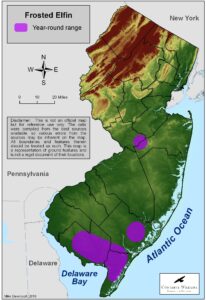Callophrys irus
Type: invertebrate
Status: threatened
Species Guide
Frosted elfin
Callophrys irus
Species Type: invertebrate
Conservation Status: threatened
Identification
The Frosted elfin is slightly larger than most other elfins that are similar in appearance. Adults range in size from 1 in.-1.25 in. (26-32 mm). Sexes are similar. The upper surface of the wings are a drab brown color. A small “tail” extending from the hindwings is a distinguishing feature used to help identify this species. The back edge of the hindwing often has a white “frosting,” for which this species is named. A black spot near the “tail” on the hindwing is almost always present and is an important field mark for proper identification. Another characteristic feature of the under side of the hindwing is a very crooked white line that runs roughly parallel to the body and divides the wing in half.

Distribution & Habitat
The Frosted elfin is present along most of the east coast, except for Maine (where it is presumed to have been extirpated), with isolated populations existing in southeastern Texas (and surrounding areas), Michigan, Indiana, and Wisconsin. New Jersey may be the stronghold for this species (Schweitzer 1994), with Assunpink Wildlife Management Area (WMA) and Belleplain State Forest having well-known colonies in the state (Gochfield and Burger 1997).
Dry clearings and open areas that are natural (e.g. savannas) or of human origin (e.g. power-line right of ways and roadsides). The presence of food plants (see Diet) is also of importance.
Diet
Lupine (Lupinus perennis) and indigo (Baptisia spp.) are the major food and host plants of this species. Larvae feed on the flowers of fruits of the host plants, and the adults are nectar feeders.
Life Cycle
Frosted elfins produce a single brood each year. Adults fly from late May to mid-June in New Jersey. The larvae or caterpillars feed on the host plants and then move into the leaf litter a few weeks after the adults stop flying in mid-June, and the larvae develop into pupae (Schweitzer 1994). Individuals overwinter as pupae in the soil or in leaf litter bound together with silk fibers. (Scott 1986).
Current Threats, Status, and Conservation
This species was listed as threatened in New Jersey in 2001. The Frosted elfin is often locally rare and occurs in small isolated populations. It is believed to be extirpated from portions of its historic range, including Maine, Ontario, and possibly Texas. It currently is not listed for federal protection, but its rarity throughout its range might justify a federal status of threatened or endangered in the near future.
In 2005, several habitat enhancement projects, one inside Millville Wildlife Management Area (WMA), established host plants (wild indigo) along utility right-of-ways. It is unclear whether the habitat enhancement projects have been successful or not.
References
- Beans, B.E. and Niles, L. 2003. Endangered and Threatened Wildlife of New Jersey.
- Schweitzer, D.F. 1994. Element ecology and life history. In The Comprehensive Report of Callophrys irus. NatureServe: An online encyclopedia of life. 2001. Version 1.5. Arlington, Virginia, USA: Association for Biodiversity Information. www.natureserve.org
Edited and updated in 2010 by Ben Wurst.
Scientific Classification
- Kingdom: Animalia
- Phylum: Arthropoda
- Class: Insecta
- Order: Lepidoptera
- Family: Lycaenidae
- Genus: Callophrys
- Species: C. irus